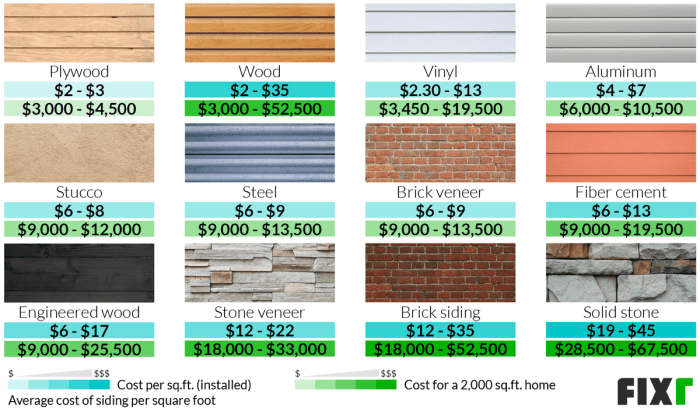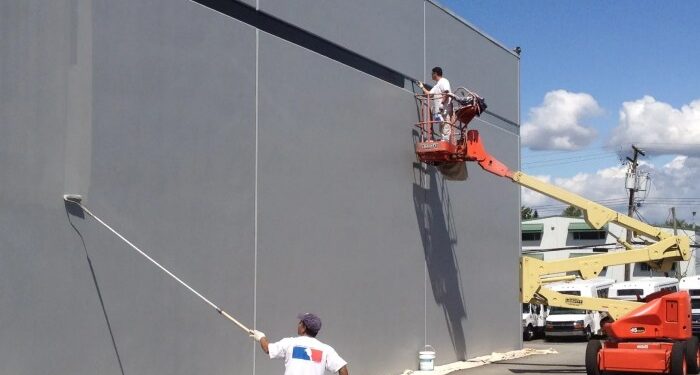Exploring the world of siding and roofing replacement cost unveils a complex web of factors that influence pricing, a variety of materials to choose from, methods for estimating costs, and options for budgeting and financing. This informative guide delves into the intricacies of each aspect, providing valuable insights for homeowners embarking on renovation projects.
.
 When it comes to siding and roofing replacement projects, effective budgeting and exploring financing options are crucial steps to ensure the success of the project without breaking the bank. Here, we will discuss various strategies for budgeting effectively and the different financing options available for homeowners.
When it comes to siding and roofing replacement projects, effective budgeting and exploring financing options are crucial steps to ensure the success of the project without breaking the bank. Here, we will discuss various strategies for budgeting effectively and the different financing options available for homeowners.
Factors Influencing Siding and Roofing Replacement Cost
When it comes to determining the cost of siding and roofing replacement, several key factors come into play. Understanding these factors can help homeowners make informed decisions and budget effectively for their renovation projects.Material Quality
The quality of materials used for siding and roofing replacement significantly impacts the overall cost. High-quality materials often come with a higher price tag but can offer better durability and longevity, reducing the need for frequent repairs or replacements.Labor Costs
Labor costs are another crucial factor that affects the total expense of replacing siding and roofing. Skilled labor and experienced contractors may charge higher fees for their services, but their expertise can ensure a more efficient and professionally executed project.Project Complexity
The complexity of the replacement project, including factors such as the size of the property, architectural design, and any additional customization or special requirements, can also influence the overall cost. More intricate projects may require additional time, resources, and expertise, leading to higher expenses.Geographical Location
Geographical location plays a significant role in pricing variations for siding and roofing replacement. Factors such as local building codes, weather conditions, availability of materials, and competition among contractors can all impact the cost of the project. Areas with higher living costs or stricter regulations may experience higher overall expenses for renovation projects.Types of Roofing and Siding Materials
When it comes to replacing roofing and siding, there are several common materials used in the construction industry. Each material has its own set of pros and cons, including factors such as durability, maintenance requirements, and initial costs.Asphalt Shingles
Asphalt shingles are one of the most popular roofing materials due to their affordability and ease of installation. They come in a variety of colors and styles, making them a versatile option for many homeowners. However, asphalt shingles may not be as durable as other materials and may require more frequent replacement over time.Metal Roofing
Metal roofing is known for its longevity and durability, with some types lasting up to 50 years or more. While metal roofing can be more expensive upfront, it requires minimal maintenance and can withstand harsh weather conditions. Additionally, metal roofing is environmentally friendly and can be recycled at the end of its lifespan.Vinyl Siding
Vinyl siding is a popular choice for homeowners looking for a low-maintenance and cost-effective siding option. It is available in a wide range of colors and styles, making it easy to customize the look of your home. However, vinyl siding may not be as durable as other materials and can crack or fade over time.Fiber Cement Siding
Fiber cement siding is a durable and long-lasting material that is resistant to rot, fire, and pests. It is low-maintenance and can mimic the look of wood or stucco without the same level of maintenance. While fiber cement siding may be more expensive than vinyl, it offers a higher level of durability and longevity.Cost Estimation Methods
Estimating the cost of siding and roofing replacement involves several key factors that need to be taken into consideration. This process requires a detailed analysis of material quantities, labor expenses, permits, and any additional costs that may arise during the project.Material Quantities Calculation
Calculating the required materials for siding and roofing replacement is crucial for an accurate cost estimate. This includes determining the square footage of the area to be covered, accounting for any waste or extra materials needed, and considering the type of materials to be used.Labor Expenses Estimation
Labor expenses play a significant role in the overall cost of siding and roofing replacement. It is essential to factor in the cost of skilled labor, the duration of the project, and any unforeseen circumstances that may affect labor costs.Permits and Additional Costs
Obtaining permits for siding and roofing replacement projects can incur additional costs. It is important to include permit fees, inspection costs, and any other miscellaneous expenses in the overall estimate to avoid budget overrunsTips for Obtaining Multiple Quotes
- Request quotes from multiple contractors to compare prices and services.
- Ensure that each quote includes a detailed breakdown of costs for materials, labor, permits, and any additional expenses.
- Consider the reputation and experience of the contractors when making your decision.
- Beware of unusually low quotes, as they may indicate subpar materials or workmanship.
Budgeting and Financing Options
 When it comes to siding and roofing replacement projects, effective budgeting and exploring financing options are crucial steps to ensure the success of the project without breaking the bank. Here, we will discuss various strategies for budgeting effectively and the different financing options available for homeowners.
When it comes to siding and roofing replacement projects, effective budgeting and exploring financing options are crucial steps to ensure the success of the project without breaking the bank. Here, we will discuss various strategies for budgeting effectively and the different financing options available for homeowners.
Strategies for Budgeting
- Start by getting multiple quotes from different contractors to compare prices and services offered.
- Set aside a contingency fund of about 10-15% of the total project cost to cover unexpected expenses.
- Prioritize necessary repairs over cosmetic upgrades to stay within budget.
- Consider the long-term savings of energy-efficient materials to reduce future maintenance costs.
Financing Options
- Home Equity Loans: Borrow against the equity in your home to finance the project at a lower interest rate.
- Personal Loans: Consider taking out a personal loan from a bank or credit union to cover the costs of the project.
- Insurance Coverage: Check if your homeowner's insurance policy covers any of the replacement costs due to damage from natural disasters or accidents.
Managing Unexpected Costs
- Communicate openly with your contractor to address any unexpected issues that may arise during the project.
- Stay flexible with your timeline in case delays occur that could impact the overall budget.
- Regularly review your budget and expenses to ensure you are staying on track and making adjustments as needed.












